In this first part of a three-part series covering the Winnipeg Jets’ offseason to-do list, I’ll be discussing the team’s forwards. In part two, I’ll discuss defensemen, and in part three, I’ll cover the goalies, estimated total cap hit, and predictions for the 2019-20 season.
An Overview of the Jets’ Remaining Forwards
The following is a depth chart for the team’s remaining forwards, including players under contract or owned by the Jets (RFAs), for the 2019-20 season:
| LW | C | RW |
| Connor (RFA) | Scheifele | Wheeler |
| Ehlers | Little | Laine (RFA) |
| Perreault | Lowry | Copp (RFA) |
| Vesalainen | Roslovic | Appleton |
| Suess | Shaw | Dano |
Despite numerous UFAs (four) and RFAs (three), the Jets’ forward roster is largely intact when compared to the past few seasons. Looking at the depth chart, one could argue that the team has a serviceable forward roster, with three lines of full-time NHL players. In fact, lines one, two, and three are more-or-less the exact same as last season. However, you’ll notice that the Jets lack a lot of experience in the penciled fourth line and talent/serviceability in the depth portion of the roster.
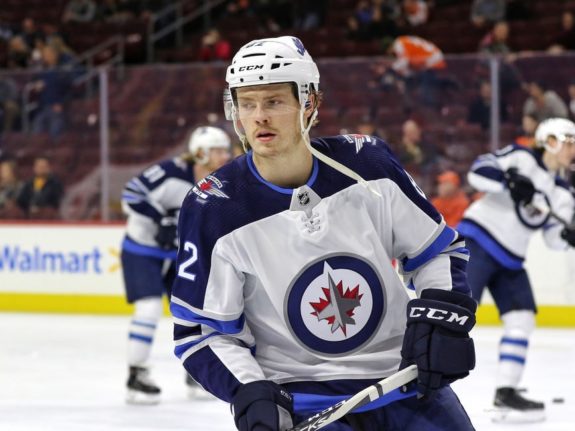
While Jack Roslovic has been a full-time NHLer for a year (which isn’t much), prospects Kristian Vesalainen and Mason Appleton have 41 games of combined experience (five and 36 games, respectively). After that, Logan Shaw and Marko Dano have a chunk of experience (180 and 138 games, respectively), C. J. Suess has no NHL experience, and all three players aren’t ideal as fourth-line fill-ins.
In addition, while Roslovic and Appleton have played center with the Jets’ AHL affiliate, the Manitoba Moose, neither has sufficient experience at Center in the NHL. Moreover, in my opinion, Andrew Copp had a fantastic season given that he played a mix of third- and fourth-line minutes and still managed 11 goals and 14 assists in 69 games. I think he looked far too good last season for the Jets to pencil him in on the fourth line this season or to put Roslovic in his place (I’ll discuss this more in-depth later). So, simply put, the Jets would be playing with fire to leave the roster as-is and not seek out free agent depth forwards, specifically at the Center position.
The Jets Have to Re-Sign RFAs Connor, Laine & Copp
Kyle Connor, Patrik Laine, and Andrew Copp all need to be re-signed by the Jets.
Connor has had back-to-back 30-plus goal seasons, 123 points over two full-time seasons, and is a regular on the Jets’ top two lines. Connor has tons of speed, is a fantastic playmaker and shooter, is great at knocking down pucks/breaking up plays, serves as the down low/tight play forward on the first power play unit, and is a perfect high/pressure forward on the penalty kill. He’s due for a big contract, but the dollar figure might be hard to predict.
One could argue that Blake Wheeler’s salary ($8.25 million/year) is the cap of what Kevin Cheveldayoff and the Jets could offer a player, but I seriously doubt he’ll get that kind of money. If I had to take a guess, I’d say he’ll get Nikolaj Ehlers ($6 million/year) or Mark Scheifele ($6.125 million/year) money, but likely at or over Scheifele due to inflation (see Artemi Panarin or Filip Forsberg as potential comparables). Connor has fit in very well with the Jets, so I doubt negotiations will be overly difficult. I’d expect him to sign long-term as well (likely four to six years).
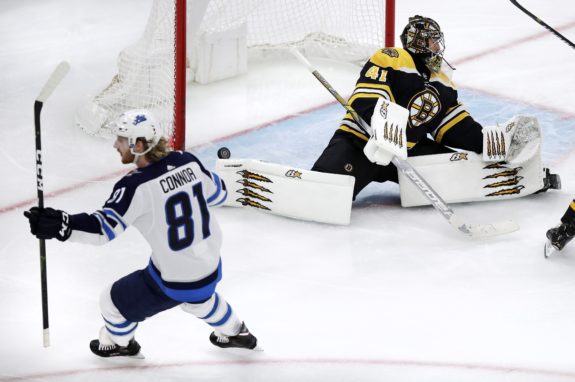
Negotiating Laine’s contract is probably going to be more difficult. It isn’t that I think he’s trouble, but that he likely has a higher ceiling overall than Connor and thus deserves more money. He has 110 goals, 74 assists, and 184 points in 237 games. That’s 0.464 goals per game and 0.776 points per game versus Connor’s 0.376 and 0.719, and Laine is a year younger. That being said, given the fact that Laine seems like a team player and Cheveldayoff is a skillful negotiator, Laine likely isn’t going to get as much as he could on the open market.
If I had to take a guess on what Laine will receive (and it’s completely a guess), it’ll probably be plus or minus Dustin Byfuglien money ($7.6 million/year), but below Wheeler. Again, I doubt this negotiation will involve much drama, especially since he’ll want to stay with his best buddy on the team (Ehlers). However, I’d expect his contract to expire before Ehlers so he can get another (likely well-deserved) pay raise; expect his contract to be three to five years.
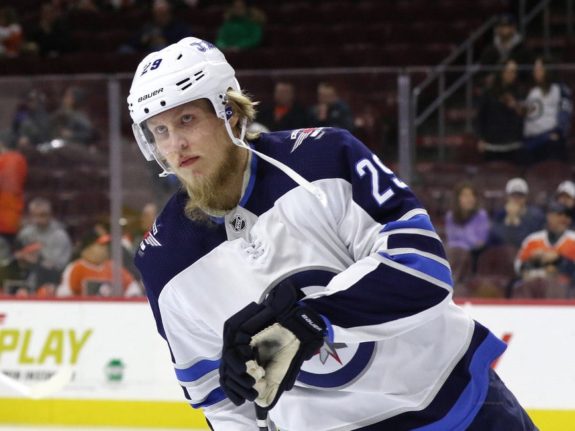
Regarding Copp, I think he’s been undervalued and underutilized. This is good news for the Jets in negotiations, but bad news for Copp. Given that he was scratched in Game 5 of the 2017-18 playoff series against the Vegas Golden Knights and had often been put on the fourth line during the 2018-19 season, I wonder how much this has affected his interest in playing in Winnipeg. That being said, he’s been Scheifele’s roommate for a little while, seems to fit in great, and rarely seems irritable, so I’m not sure that he has a bad taste in his mouth regarding his time with the Jets.
In any case, since the Jets control Copp’s rights and he’s a great all-around player (did you see his plus-20 plus/minus?!), I would be very surprised if the Jets can’t keep him around at a very reasonable price tag. However, expect it to be short-term (probably only one year) so he can keep his options open and receive a pay increase if he has a good season. He’ll probably fetch $1.25-$1.5 million.
The Jets Need to Re-Sign UFA Tanev (And Pick up Depth Forwards)
As mentioned earlier, I think the fourth line and depth forwards are lacking, but I’ll likely be proven wrong in one or more ways. I thought Appleton looked responsible and NHL-ready (or close enough) this past season, so he could turn out being a regular. Vesalainen is a high-end, skilled prospect who’s one year older, so he could make the roster. And given that Roslovic was a full-timer, one would expect him to stick around. So, who knows what will happen in the bottom six.
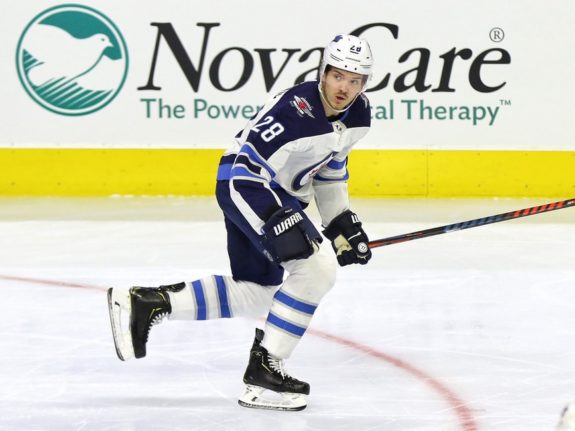
Personally, I’m not big on Roslovic. From what I’ve seen of him, he tries to do too much (i.e. dangle instead of making the simple play), and I don’t know if he’ll be as good long-term as Appleton or Vesalainen. Moreover, as we’ve already established, there are three lines of full-time NHLers, all of whom I’d have ahead of Roslovic (either as shut-down or offensive forwards). Technically, Roslovic could be moved down to the Moose to get ice time, but I think he’s too good to be there. And if either or both of Appleton and Vesalainen out-perform him, where does he fit in?
Similar things can be said about Mathieu Perreault. I don’t know how the Jets could justify playing Perreault on the fourth line again at $4.125 million if players out-perform him as they did this past season. This is especially true given the expected lack of cap space. Equally, I don’t know how they’ll be able to move his contract; while he’s a decent player, most other teams likely will not be able to find a spot for him or one where they’re getting good value. Also, he has a modified no-trade clause, which could make it slightly more difficult. Since a buyout likely doesn’t make sense from a cost-benefit perspective, the Jets might be stuck.
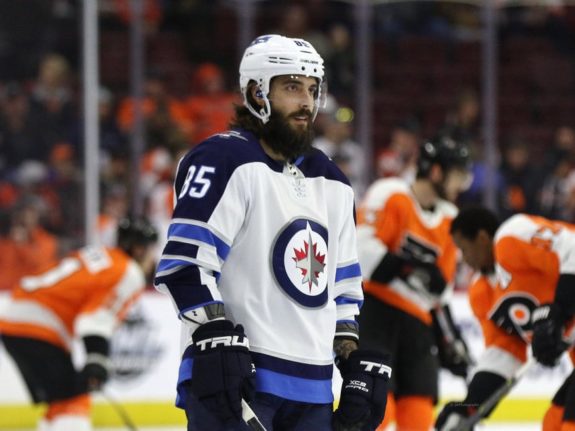
So, let’s say that the Jets can re-sign the speedy, heart-and-soul Tanev (I sure hope they can) and Appleton and/or Vesalainen make their case to stay on the team. That means you could have four to five players (Tanev, Lowry, Copp, and Vesalainen and/or Appleton) worthy of third-line minutes, with two more (Perreault and Roslovic) who should be playing third-line minutes somewhere. While it’s a good problem to have, it’s one that now seems to be nagging the team and negatively impacting player development.
Now, here’s where playing general manager is opinion-based and unique to each person; nobody knows what Cheveldayoff has planned. But, if it were up to me, Tanev (who must be worth somewhere in the $1.8-$2 million/year range; see Luke Glendening as a comparable) and Copp are absolute, must-have players on the third line. Personally, I think Copp was a stronger player last season than Lowry, and I have a feeling this trend will continue.
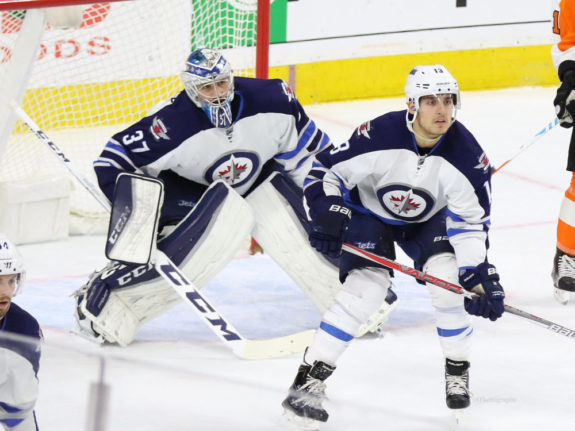
Since I think Tanev and Copp both have offensive upside, I’d change the direction of the third line and give it more of an offensive twist. Since I also think Vesalainen and/or Appleton will crack the squad (likely Vesalainen), it would probably be one of them to round out the line. If not, given that Perreault likely can’t be traded and probably shouldn’t be bought out, he could fill out that line as well.
So, as odd as this may sound, if Tanev can be re-signed, I see Lowry as the odd man out and easiest to be traded (especially to clear cap space for the signings of Connor, Laine, and everyone else). Likewise, in my opinion, trading Roslovic (maybe in a package with Trouba) might be worth considering to make room for the development of other players. And lastly, to round out the lines, re-signing Par Lindholm (who I thought was a great fit) and one or two other free agent depth forwards would fill in the rest of the holes.
Summary & Potential Forward Depth Chart for the 2019-20 Season
Based on all of the aforementioned, here’s how I’d argue the Jets should look to fill their forward lines to start next season:
| LW | C | RW |
| Connor | Scheifele | Wheeler |
| Ehlers | Little | Laine |
| Vesalainen/Perreault | Copp | Tanev |
| Vesalainen/Perreault | Lindholm/Other (Free Agent) | Appleton |
| Other (Free Agent) | Roslovic |
Estimated cap hit (in $ millions):
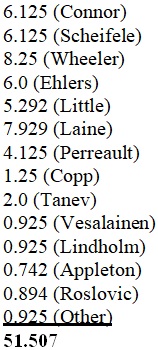
And if there are no additions to the team (see the depth chart at the beginning of the article) and we assume my salary estimates are close to right, the estimated cap hit (in $ millions) would be:

The salary cap increased by 2.24 percent ($1.6 million) from 2015-16 to 2016-17, 2.74 percent ($2.0 million) from 2016-17 to 2017-18, and 6.00 percent ($4.5 million) from 2017-18 to 2018-19. If we take the average, which would be 3.66 epercent, we can estimate the cap will be $82.41 million for the 2019-20 season. This is ballpark what the NHL forecasted ($83 million) back in December, 2018.
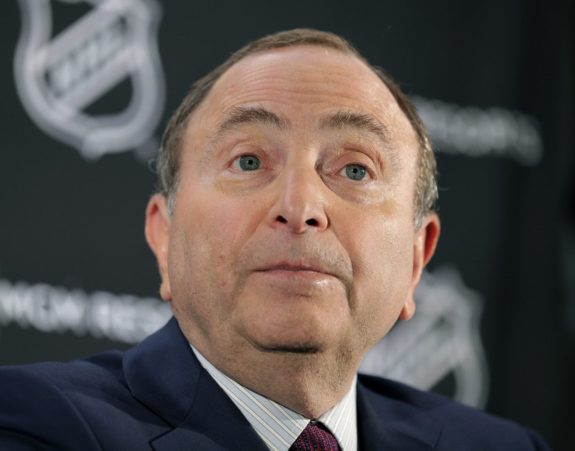
Therefore, using my estimated cap (which is lower/more conservative) and the aforementioned estimated cap hits for the Jets’ forwards, the team will likely have between $29.986-$30.903 million left to spend on its defensemen and goalies. That isn’t much! So far, it looks like the Jets are going to be super tight to the cap if they re-sign their top-end forwards!